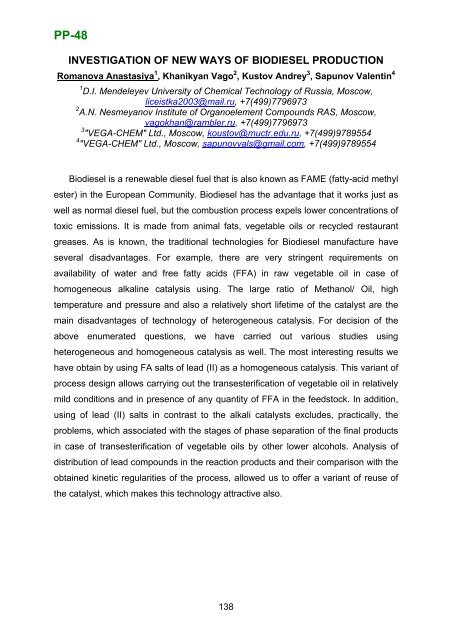Boreskov Institute of Catalysis SB RAS, Novosibirsk, Russia
Boreskov Institute of Catalysis SB RAS, Novosibirsk, Russia
Boreskov Institute of Catalysis SB RAS, Novosibirsk, Russia
- No tags were found...
Create successful ePaper yourself
Turn your PDF publications into a flip-book with our unique Google optimized e-Paper software.
PP-48INVESTIGATION OF NEW WAYS OF BIODIESEL PRODUCTIONRomanova Anastasiya 1 , Khanikyan Vago 2 , Kustov Andrey 3 , Sapunov Valentin 41 D.I. Mendeleyev University <strong>of</strong> Chemical Technology <strong>of</strong> <strong>Russia</strong>, Moscow,liceistka2003@mail.ru, +7(499)77969732 A.N. Nesmeyanov <strong>Institute</strong> <strong>of</strong> Organoelement Compounds <strong>RAS</strong>, Moscow,vagokhan@rambler.ru, +7(499)77969733 "VEGA-CHEM" Ltd., Moscow, koustov@muctr.edu.ru, +7(499)97895544 "VEGA-CHEM" Ltd., Moscow, sapunovvals@gmail.com, +7(499)9789554Biodiesel is a renewable diesel fuel that is also known as FAME (fatty-acid methylester) in the European Community. Biodiesel has the advantage that it works just aswell as normal diesel fuel, but the combustion process expels lower concentrations <strong>of</strong>toxic emissions. It is made from animal fats, vegetable oils or recycled restaurantgreases. As is known, the traditional technologies for Biodiesel manufacture haveseveral disadvantages. For example, there are very stringent requirements onavailability <strong>of</strong> water and free fatty acids (FFA) in raw vegetable oil in case <strong>of</strong>homogeneous alkaline catalysis using. The large ratio <strong>of</strong> Methanol/ Oil, hightemperature and pressure and also a relatively short lifetime <strong>of</strong> the catalyst are themain disadvantages <strong>of</strong> technology <strong>of</strong> heterogeneous catalysis. For decision <strong>of</strong> theabove enumerated questions, we have carried out various studies usingheterogeneous and homogeneous catalysis as well. The most interesting results wehave obtain by using FA salts <strong>of</strong> lead (II) as a homogeneous catalysis. This variant <strong>of</strong>process design allows carrying out the transesterification <strong>of</strong> vegetable oil in relativelymild conditions and in presence <strong>of</strong> any quantity <strong>of</strong> FFA in the feedstock. In addition,using <strong>of</strong> lead (II) salts in contrast to the alkali catalysts excludes, practically, theproblems, which associated with the stages <strong>of</strong> phase separation <strong>of</strong> the final productsin case <strong>of</strong> transesterification <strong>of</strong> vegetable oils by other lower alcohols. Analysis <strong>of</strong>distribution <strong>of</strong> lead compounds in the reaction products and their comparison with theobtained kinetic regularities <strong>of</strong> the process, allowed us to <strong>of</strong>fer a variant <strong>of</strong> reuse <strong>of</strong>the catalyst, which makes this technology attractive also.138
















